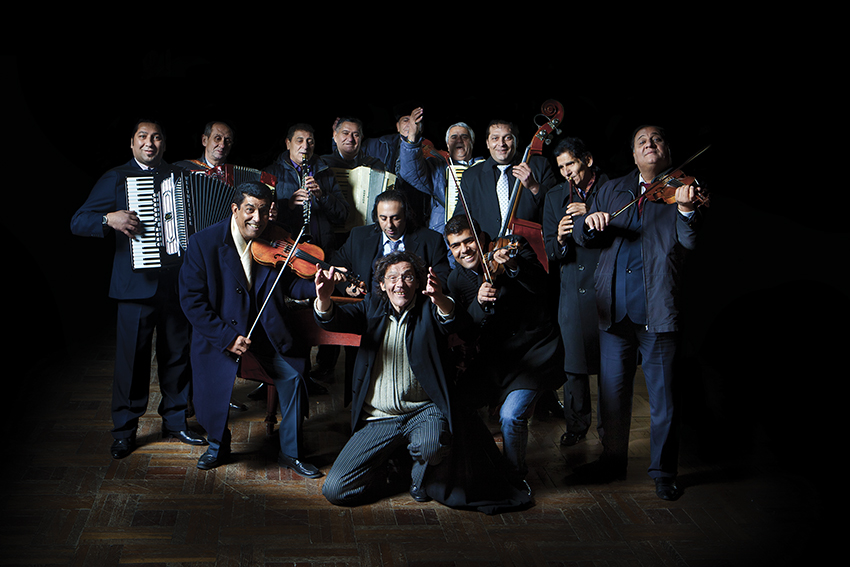 Described by a UK daily newspaper as “The best Gypsy band in the world”, Taraf de Haïdouks are considered as the epitome of Gypsy music’s fabulous vitality ever since the release of their debut album and their first visit to western Europe back in 1990. They’ve relentlessly toured all around the globe, have released acclaimed albums, and their countless fans include people like the late Yehudi Menuhin, Kronos Quartet (with whom they’ve recorded and performed), actor Johnny Depp (alongside whom they appeared in the film “The Man Who Cried”), fashion designer Yohji Yamamoto (who invited them to be models-cum-musicians for his Paris and Tokyo shows) choreographer Pina Bausch, Stephan Eicher and many more. Their music was used in numerous films, such as Terry Gilliam’s “The Brothers Grimm” and “Train of Life” by Radu Mihaileanu. Meanwhile, the band members seem to have been relatively unaffected by all this attention, they’ve retained their sense of humour, and their way of life (they still reside in their modest village of Clejani, in the Wallachian countryside).
Described by a UK daily newspaper as “The best Gypsy band in the world”, Taraf de Haïdouks are considered as the epitome of Gypsy music’s fabulous vitality ever since the release of their debut album and their first visit to western Europe back in 1990. They’ve relentlessly toured all around the globe, have released acclaimed albums, and their countless fans include people like the late Yehudi Menuhin, Kronos Quartet (with whom they’ve recorded and performed), actor Johnny Depp (alongside whom they appeared in the film “The Man Who Cried”), fashion designer Yohji Yamamoto (who invited them to be models-cum-musicians for his Paris and Tokyo shows) choreographer Pina Bausch, Stephan Eicher and many more. Their music was used in numerous films, such as Terry Gilliam’s “The Brothers Grimm” and “Train of Life” by Radu Mihaileanu. Meanwhile, the band members seem to have been relatively unaffected by all this attention, they’ve retained their sense of humour, and their way of life (they still reside in their modest village of Clejani, in the Wallachian countryside).
Ever since their first visit to western Europe back in 1991, Taraf de Haïdouks have been considered as the epitome of Gypsy music’s fabulous vitality. They’ve relentlessly toured all around the globe, have released acclaimed albums and a DVD, and their countless fans include people like the late Yehudi Menuhin, Kronos Quartet (with whom they’ve recorded and performed), actor Johnny Depp (alongside whom they appeared in the film “The Man Who Cried”), fashion designer Yohji Yamamoto (who invited them to be models-cum-musicians for his Paris and Tokyo shows) and many more. Meanwhile, the band members seem to have been relatively unaffected by all humdrum, they’ve retained their sense of humour, and their way of life (they still reside in their modest village of Clejani, in the Valachian countryside).
The Taraf de Haïdouks is a group of Gypsy “Lautari” (traditional musicians) who come from the little Romanian village of Clejani. A dozen brilliant instrumentalists and singers, with ages ranging roughly from 20 to 80, they had never performed outside their region before they were “discovered” by Stéphane Karo & Michel Winter, two young Belgian music fans who fell in love with their music during a trip to Romania in 1990, and who decided to try to share this passion with the rest of the world.
Released in 1991, their first album (“Musique des Tsiganes de Roumanie”), introduced Western listeners to the rich musical world of the Romanian Gypsies, which includes medieval ballads, Turkish-flavoured dance tunes from the Balkans, and characteristic vocal inflections which are reminiscent of the Gypsy people’s origins in the Indian sub-continent.
The band’s albums and concerts originally alternated ballads and country-style dances showcasing elderly, emblematic vocalists/instrumentalists Neacsu, Ion Manole, Cacurica and Ilie Iorga, with more virtuosic instrumental pieces composed and arranged by the Taraf’s young guard: violonist Caliu, accordionists Ionitsa and Marius, flautist Falcaru and cymbalum player Ionica, to name but a few.
The Taraf’s line-up has gradually evolved: new musicians and singers joined the band (violonist Costica, double bass player Viorel, vocalist Pasalan, accordionist Marin Manole), Bulgarian clarinet player Filip Simeonov (who was invited for the “Band Of Gypsies” recording and stayed on). Three of the older Taraf members sadly passed away (Ion Manole, Neacsu and Cacurica). And now a 3rd generation of players has started joining the band, as the sons of Caliu, Costica and Viorel -all of them brilliant musicians in their early twenties- have started carrying the torch.